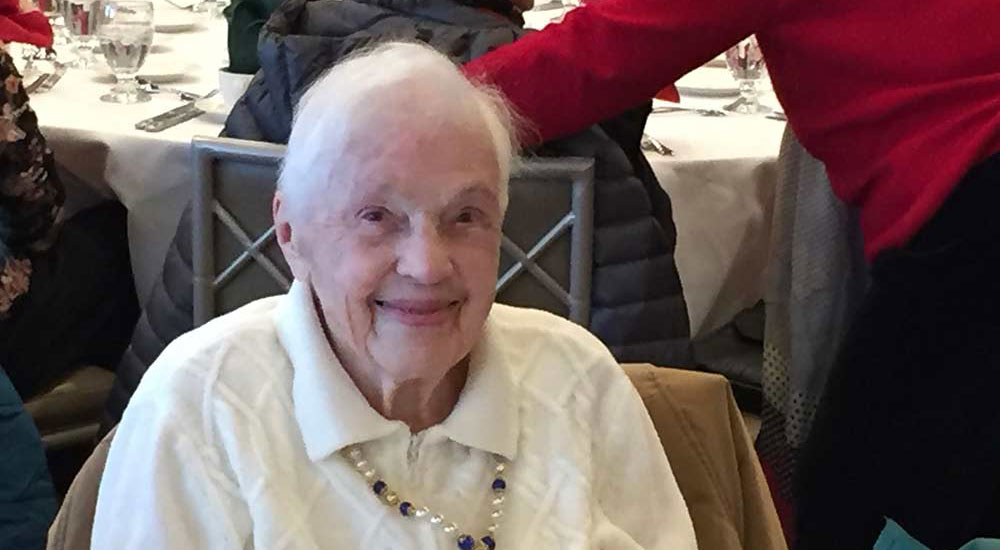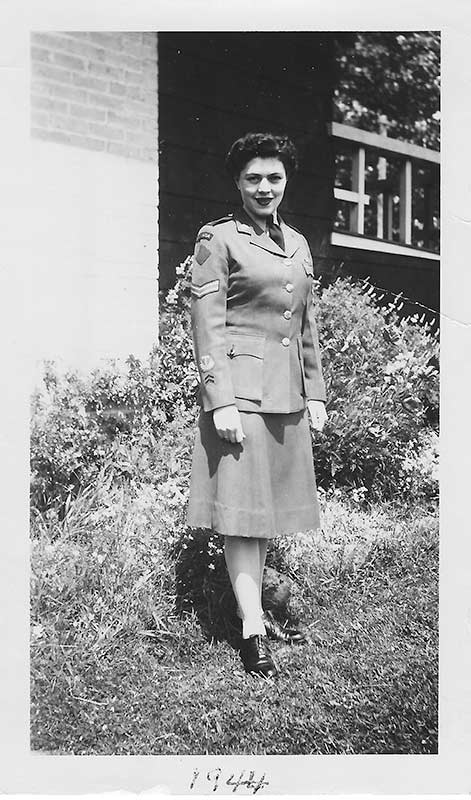Sergeant (Ret’d) Marjorie (Worby) Stetson
Sergeant (Ret’d) Marjorie (Worby) Stetson was born in Montreal, Quebec. She remembers hearing stories about war from her father, George Worby, who served in the First and Second World Wars. Her father’s service inspired her to enlist with the Canadian Women’s Army Corps (CWAC) in 1942 at the age of 18.

From her first days in the CWAC, Marjorie wanted to make a difference and learn new skills. Her father told her that the Army provides opportunities and she should take advantage of any new roles offered. “I was scrubbing floors that first day when I was asked if I would be interested in taking a course on telegraphy.” Marjorie promptly agreed, and the next morning she boarded a train for Kingston, Ontario with a dozen other recruits.
The next day, Marjorie and other CWAC members were transported to a barrack outside of Kingston where they would learn Morse code. Marjorie enjoyed her coursework and was particularly good at mastering Morse code. She was soon selected to hone her newly learned skillset in Ottawa and was posted to a unit titled #1 Special Wireless Station (SWS). “We were billeted in special barracks and schooled in utmost secrecy. In other words, we were ordered to tell no one what we were learning.” Marjorie completed all of her tests while at #1SWS, and became increasingly skilled at a particular task – listening to and copying down Japanese Morse code, known as Kana code.
“I inquired where the copies of our work were sent. The answer I got was ‘Washington,’ and I was told not to ask any further questions.”
Marjorie’s advanced skillset took her across the country to Victoria, British Columbia, “to a small white building on a plum farm out in the woods,” as she describes it. That building turned out to be #3SWS, Marjorie’s work place for the remainder of the war effort. Her specific assignment was to locate on her receiver a good wireless signal of Japanese military communication in the Pacific, lock onto that signal and transcribe the Japanese code she heard onto paper using a special typewriter.
“No one knew what we were doing, no one was allowed to visit our station.” Throughout her time at #3SWS, Marjorie remained curious. “I inquired where the copies of our work were sent. The answer I got was ‘Washington,’ and I was told not to ask any further questions.”

Marjorie completed her service in 1946 and again was sworn to secrecy. Shortly after the war, she was invited to St. Albans, Vermont for a celebration marking the end of the Second World War. Canadians from all branches of the military attended, wearing uniforms and carrying flags in celebration. It was there that Marjorie met her future husband. “We sat down for the reception, and this American sailor walked through the door… and I knew right away.” Marjorie and Arthur Bartlett Stetson married on 18 June 1949. They settled in Massachusetts for most of their adult life. Mr. Stetson passed away in 2012, never really knowing the extent of Marjorie’s service. “He always just assumed I was an office clerk.”
Marjorie thinks back fondly on the lasting relationships she built while with the CWAC. “The girls from #3SWS held a reunion every year. Our last one was held in 1982 in Ottawa, where we took pictures in front of the National War Memorial. There were nine of us there for that final reunion. We remained a close group, and at the time still living with our secret. As far as I know, at 96, I am now the only one of our group still alive.”
A few years after Mr. Stetson’s passing, Marjorie discovered the book Code Girls written by Liza Mundy. The factual book recounts how the U.S Army and Navy recruited women to assist with breaking codes. Many of these women were stationed in Washington, and all were sworn to secrecy.
“We copied and they unscrambled. Now I know what happened to our copies.”
Upon reading the book, Marjorie identified parallels between the Code Girls and the work of the CWAC at #3SWS. “The book details how a group of young women worked in Washington deciphering code. They just simply completed their jobs, and at the end of the war no one told them what they had been doing. Just as mysterious were the facts these women never knew where all the code came from… and our group never knew where our copies were sent.”
Marjorie is convinced that the code she copied during the war was sent to Washington for the Code Girls to decipher. “We copied and they unscrambled. Now I know what happened to our copies.”
Marjorie wants to share her story so that Canadians, both young and old, are aware of the contributions of CWAC members who served at #3SWS. “My parents, relatives, gosh even my husband, were never aware of what I did. We all said the same thing… we just worked in an office as a clerk. I truly didn’t feel like I served until I read Liza’s book.”
After being discharged from the CWAC in 1946, Marjorie returned home to Montreal and applied for a civilian job at the Department of Transportation. “I told the chap on duty that I had just completed four years working as a First Class Radio Operator. But he replied that they did not employ women because that was a man’s job. I left feeling somewhat dejected. But what could I say? Everything was still a big secret.” Marjorie thinks of her story being written up now as a tribute to the many women who served. “No one knew what some of us accomplished during the war and because of that, no one ever said thank you… until now.”
Finally, a piece of advice from Marjorie: “Don’t hesitate to ask your grandmother what she did during the war. She just might have an amazing tale or big secret to share with you!”
Marjorie currently resides in Concord, Massachusetts, outside of Boston, and is 96 years old. She has three sons, five grandchildren and five great‑grandchildren. She is very proud to be a Canadian Veteran.
- Date modified: